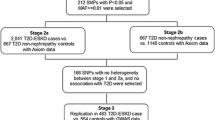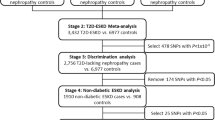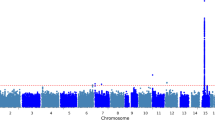Abstract
We previously investigated the estrogen receptor α gene (ESR1) as a positional candidate for type 2 diabetes (T2DM), and found evidence for association between the intron 1-intron 2 region of this gene and T2DM and/or nephropathy in an African American (AA) population. Our objective was to comprehensively evaluate variants across the entire ESR1 gene for association in AA with T2DM and end stage renal disease (T2DM–ESRD). One hundred fifty SNPs in ESR1, spanning 476 kb, were genotyped in 577 AA individuals with T2DM–ESRD and 596 AA controls. Genotypic association tests for dominant, additive, and recessive models, and haplotypic association, were calculated using a χ2 statistic and corresponding P value. Thirty-one SNPs showed nominal evidence for association (P < 0.05) with T2DM–ESRD in one or more genotypic model. After correcting for multiple tests, promoter SNP rs11964281 (nominal P = 0.000291, adjusted P = 0.0289), and intron 4 SNPs rs1569788 (nominal P = 0.000754, adjusted P = 0.0278) and rs9340969 (nominal P = 0.00109, adjusted P = 0.0467) remained significant at experimentwise error rate (EER) P ≤ 0.05 for the dominant class of tests. Twenty-three of the thirty-one associated SNPs cluster within the intron 4–intron 6 regions. Gender stratification revealed nominal evidence for association with 35 SNPs in females (352 cases; 306 controls) and seven SNPs in males (225 cases; 290 controls). We have identified a novel region of the ESR1 gene that may contain important functional polymorphisms in relation to susceptibility to T2DM and/or diabetic nephropathy.


Similar content being viewed by others
References
Arslanian SA (2002) Metabolic differences between Caucasian and African-American children and the relationship to type 2 diabetes mellitus. J Pediatr Endocrinol Metab 15(Suppl 1):509–517
Barrett JC, Fry B, Maller J, Daly MJ (2005) Haploview: analysis and visualization of LD and haplotype maps. Bioinformatics 21:263–265
Bjornstrom L, Sjoberg M (2002) Signal transducers and activators of transcription as downstream targets of nongenomic estrogen receptor actions. Mol Endocrinol 16:2202–2214
Brancati FL, Kao WH, Folsom AR, Watson RL, Szklo M (2000) Incident type 2 diabetes mellitus in African American and white adults: the Atherosclerosis Risk in Communities Study. JAMA 283:2253–2259
Buetow KH, Edmonson M, MacDonald R, Clifford R, Yip P, Kelley J, Little DP, Strausberg R, Koester H, Cantor CR, Braun A (2001) High-throughput development and characterization of a genomewide collection of gene-based single nucleotide polymorphism markers by chip-based matrix-assisted laser desorption/ionization time-of-flight mass spectrometry. Proc Natl Acad Sci USA 98:581–584
de Bakker PI, Yelensky R, Pe’er I, Gabriel SB, Daly MJ, Altshuler D (2005) Efficiency and power in genetic association studies. Nat Genet 37:1217–1223
Gabriel SB, Schaffner SF, Nguyen H, Moore JM, Roy J, Blumenstiel B, Higgins J, DeFelice M, Lochner A, Faggart M, Liu-Cordero SN, Rotimi C, Adeyemo A, Cooper R, Ward R, Lander ES, Daly MJ, Altshuler D (2002) The structure of haplotype blocks in the human genome. Science 296:2225–2229
Gallagher CJ, Keene KL, Mychaleckyj JC, Langefeld CD, Hirschhorn JN, Henderson BE, Gordon CJ, Freedman BI, Rich SS, Bowden DW, Sale MM (2007) Investigation of the estrogen receptor-alpha gene with type 2 diabetes and/or nephropathy in African-American and European-American populations. Diabetes 56:675–684
Heine PA, Taylor JA, Iwamoto GA, Lubahn DB, Cooke PS (2000) Increased adipose tissue in male and female estrogen receptor-alpha knockout mice. Proc Natl Acad Sci USA 97:12729–12734
Hirata S, Shoda T, Kato J, Hoshi K (2003) Isoform/variant mRNAs for sex steroid hormone receptors in humans. Trends Endocrinol Metab 14:124–129
International HapMap Consortium (2005) A Haplotype map of the human genome. Nature 437(7063):1299–1320
Livingstone C, Collison M (2002) Sex steroids and insulin resistance. Clin Sci (Lond) 102:151–166
Louet JF, LeMay C, Mauvais-Jarvis F (2004) Antidiabetic actions of estrogen: insight from human and genetic mouse models. Curr Atheroscler Rep 6:180–185
Mankhey RW, Bhatti F, Maric C (2005) 17beta-Estradiol replacement improves renal function and pathology associated with diabetic nephropathy. Am J Physiol Renal Physiol 288:F399–F405
Margolis KL, Bonds DE, Rodabough RJ, Tinker L, Phillips LS, Allen C, Bassford T, Burke G, Torrens J, Howard BV (2004) Effect of oestrogen plus progestin on the incidence of diabetes in postmenopausal women: results from the women’s health initiative hormone trial. Diabetologia 47:1175–1187
Sale MM, Freedman BI, Langefeld CD, Williams AH, Hicks PJ, Colicigno CJ, Beck SR, Brown WM, Rich SS, Bowden DW (2004) A genome-wide scan for type 2 diabetes in African-American families reveals evidence for a locus on chromosome 6q. Diabetes 53:830–837
Saxena R, Voight BF, LyssenkoV, Burtt NP, de Bakker PI, Chen H, Roix JJ, Kathiresan S, Hirschhorn JN, Daly MJ, Hughes TE, Groop L, Altshuler D, Almgren P, Florez JC, Meyer J, Ardlie K, Bengtsson Bostrom K, Isomaa B, Lettre G, Lindblad U, Lyon HN, Melander O, Newton-Cheh C, Nilsson P, Orho-Melander M, Rastam L, Speliotes EK, Taskinen MR, Tuomi T, Guiducci C, Berglund A, Carlson J, Gianniny L, Hackett R, Hall L, Holmkvist J, Laurila E, Sjogren M, Sterner M, Surti A, Svensson M, Tewhey R, Blumenstiel B, Parkin M, Defelice M, Barry R, Brodeur W, Camarata J, Chia N, Fava M, Gibbons J, Handsaker B, Healy C, Nguyen K, Gates C, Sougnez C, Gage D, Nizzari M, Gabriel SB, Chirn GW, Ma Q, Parihk H, Richardson D, Ricke D, Purcell S (2007) Genome-wide association analysis identifies loci for type 2 diabetes and triglyceride levels. Science 316(5829):1331–1336
Seed M (2002) The choice of hormone replacement therapy or statin therapy in the treatment of hyperlipidemic postmenopausal women. Atheroscler Suppl 3:53–63
Smith EP, Boyd J, Frank GR, Takahashi H, Cohen RM, Specker B, Williams TC, Lubahn DB, Korach KS (1994) Estrogen resistance caused by a mutation in the estrogen-receptor gene in a man. N Engl J Med 331:1056–1061
Speer G, Cseh K, Winkler G, Vargha P, Braun E, Takacs I, Lakatos P (2001) Vitamin D and estrogen receptor gene polymorphisms in type 2 diabetes mellitus and in android type obesity. Eur J Endocrinol 144:385–389
Tang H, Peng J, Wang P, Risch NJ (2005) Estimation of individual admixture: analytical and study design considerations. Genet Epidemiol 28:289–301
Wang Z, Zhang X, Shen P, Loggie BW, Chang Y, Deuel TF (2005) Identification, cloning, and expression of human estrogen receptor-alpha36, a novel variant of human estrogen receptor-alpha66. Biochem Biophys Res Commun 336:1023–1027
Wellcome Trust Case Control Consortium (2007) Genome-wide association study of 14,000 cases of seven common diseases and 3,000 shared controls. Nature 447(7145):661–678
Westfall PH, Young SS (1993) Resampling-based multiple testing: examples and methods for p-value adjustment. Wiley, New York
Yu H, Bowden DW, Spray BJ, Rich SS, Freedman BI (1996) Linkage analysis between loci in the renin-angiotensin axis and end-stage renal disease in African Americans. J Am Soc Nephrol 7:2559–2564
Acknowledgments
We thank the patients and staff of the Southeastern Kidney Council/ESRD Network 6 and individuals recruited as controls for their participation. Thanks also to recruiters Joyce Byers and Mitzie Spainhour, technician Candace Gordon, programmer Matt Stiegert, and Mark Hansen and colleagues at Illumina Inc. This work was supported by grants DK066358, DK072550, the Wake Forest University General Clinical Research Center M01 RR07122, and a Career Development Award from the American Diabetes Association (MMS).
Author information
Authors and Affiliations
Corresponding author
Electronic supplementary material
Rights and permissions
About this article
Cite this article
Keene, K.L., Mychaleckyj, J.C., Smith, S.G. et al. Comprehensive evaluation of the estrogen receptor α gene reveals further evidence for association with type 2 diabetes enriched for nephropathy in an African American population. Hum Genet 123, 333–341 (2008). https://doi.org/10.1007/s00439-008-0482-z
Received:
Accepted:
Published:
Issue Date:
DOI: https://doi.org/10.1007/s00439-008-0482-z




